Rank Species | ||
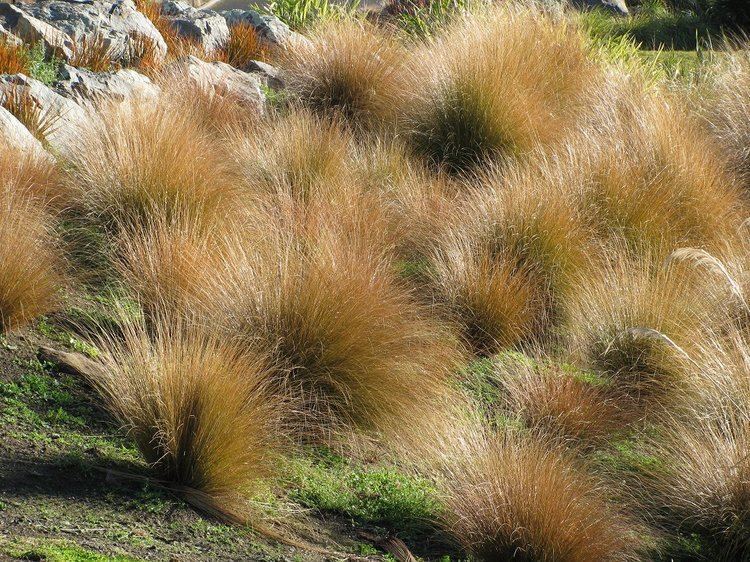 | ||
Similar Chionochloa, Chionochloa flavicans, Carex secta, Austroderia richardii, Austroderia | ||
Description
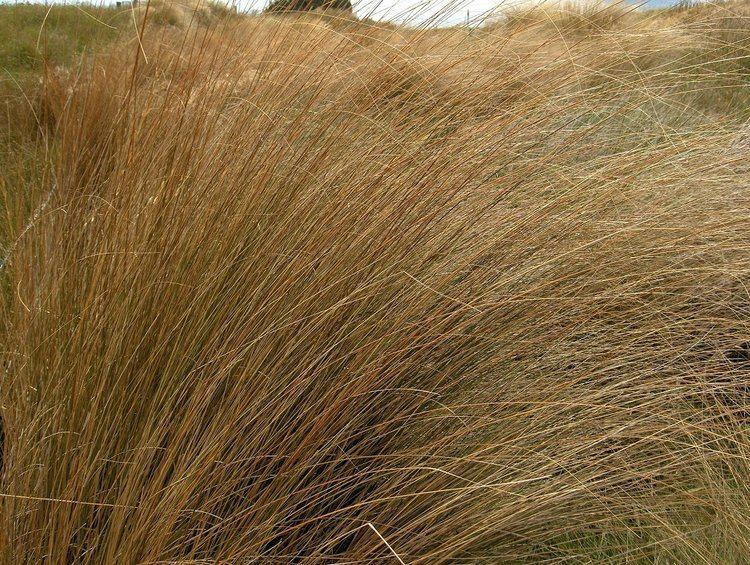
New Zealand has 22 species of Chionocloa that are endemic to New Zealand this includes the Chionocloa rubra which looks distinctively different from the rest. It has a long living span which means that there is rarely any dead foliage around the plant. This give it a clean, sleek and vertical look. The plant will grow up to 1–1.2m high in rich moist ground with seed heads reaching even taller. The leaf blade themselves grow up to 1 m long and 1.2 mm in diameter and the plant width itself is 50 cm in diameter (with little rhizomatous spread). (Kelly, D. 2000) There is usually long hairs next to the base of the leaf and prickle-teeth towards the apex that help it distinguish itself from other Chionocloa species. There is also rows of short hairs at the base of the leaf However, in dry habitat conditions such as dry clay soil the plant struggles to grow and only reaches about 90 cm high so it can be confused for other species of Chionocloa. So when trying to find this plant make sure to take the environment into account. Depending on its subspecies the tawny leafs color ranges from a beautiful greenish tone to its more dominant rustic color of bronze or red. This makes it one of the most aesthetically pleasing tussocks as green and red are known as complementary colors. In summary Chionocloa rubra is a tall brown reddish plant with slender leafs that clump together forming its trade mark arc shape.(New Zealand Plant Conservation Network. 2014)
Contents
- Description
- Natural global range
- New Zealand range
- Habitat preferences
- Life cyclePhenology
- Diet and foraging
- Predators Parasites and Diseases
- Cultural uses
- Interesting fact
- References
Natural global range
Chionochloa rubra is a native species in New Zealand. (Connor & Edgar, 1999; Wardle, 1991)
New Zealand range
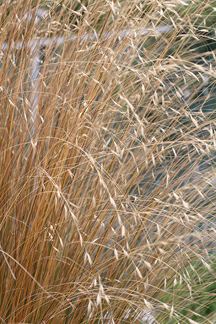
Red tussock (C. rubra) is a hardy grass dispersed from the central volcanic fields and Huiarau Range to Stewart Island, and from the lower area of the penalpine belt to sea level in south of New Zealand. (Wardle, 1991)
Habitat preferences
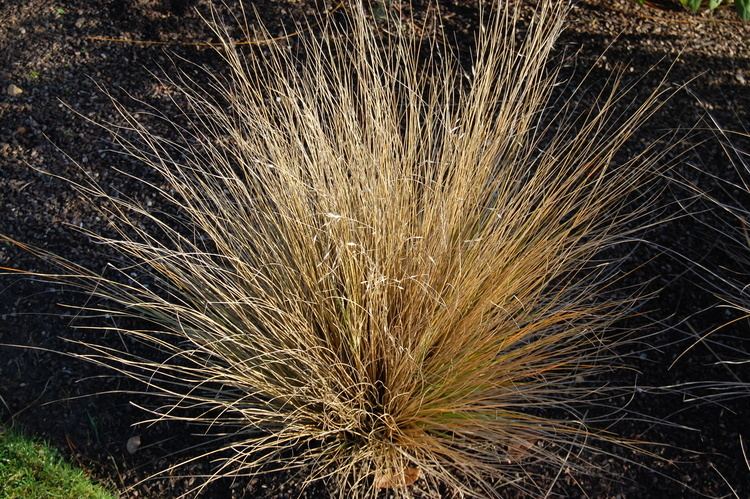
There are two different types of tussock-grassland, the one where commonly small tussock-grasses dominate, called: “Low tussock-grassland”, and other where generally larger tussocks dominate, called “Tall tussock-grassland” (Cockayne, 1958) Res tussock (Chionochloa rubra) is distributed in general Tall tussock-grassland, and covers most of the pumice-scoria soil located on the volcanic plateau at the altitude between 900 and 1200 m. The place that associated with wetland, their formation will be changed by the red tussock, because the master seeding and dense growing habit, other spices cannot tolerate the diminution of light environment, (Cockayne, 1958)
Life cycle/Phenology

The Chionochloa rubra plant's seeds are dispersed with the use of gravity and the wind. Nature is the plants main pollinating agent with very little use of invertebrates or mammals as pollinating agents. Mass seeding is used as the main technique to prevent seed loss by predators (which are hard to satisfy due to their big appetite) and other competitor plants. Mass seeding is the production of a large quantity of seeds that are released all at once over a large area. It usually takes plant a few year to produce enough seed to carry out the process. This form of spreading is particularly more prominent in the Takahe Valley in the Southland of New Zealand. Statistics and studies have shown that the mean annual loss ranges from 10–33% during a four-year studies in the Takahe Valley. So if not for mass seeding the plant would not be able to be successful as it is. (Kelly, D. 2000) The seed is dropped on well drained and moist soil where starts to grow. It flowers during the summer season from October to December and grows fruits all around from November to May.(New Zealand Plant Conservation Network. 2014)
Diet and foraging
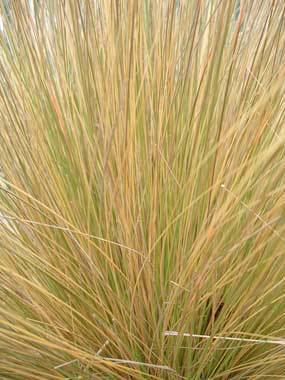
Red tussock (Chionochloa rubra) is a most adaptable vegetation which will grow in the exposed and windy environment. It can tolerate low-nutritious, and also can grow in relatively wet or dry soil conditions. (Cockayne, 1958; Metcalf, 1998). It is harsh enough to use one individual specimen plant however, if space allowed, would be better for planted several as a group. Red tussock (Chionochloa rubra) is a useful vegetation for helping to reestablish wildlife habitat, especially useful as a buffer plant around wetland areas. (Metcalf, 1998).

While the Chionochloa rubra can be slow growing and prefers more cooler, wet and less humid climates. Though once established it is very resistant plan and can take plenty of abuse due to its hardy texture. (New Zealand Plant Conservation Network. 2014)
Predators, Parasites, and Diseases
In the area of volcanic plateau is no longer untouched, wild horses and cows having feed on it for many years and more recently rabbits having become a common visitors on these tussock lands. But the status of the red tussock (Chionochloa rubra) is still primitive. (Cockayne, 1958)
The inflorescences of the Chionochloa spp. are attacked by at least two flies and one moth. The research taken place in Mt Hut, Canterbury, and two flies fed on Chionochloa pollens's inflorescences, eggs and larvae of Diplotoxa similis (Diptera: Chloropidae) appear in the inflorescences while they grew, the larvae are mainly eat flowers, and much Diplotoxa similis has pupated by the end of the flowering span, and maybe over the winter as adults. Another fly was an unclassed cecidomyiid, eggs of it are laid into the Chionochloa pollens’s, floret when the time of flowering, and hatch to early stage larvae, late-stage larvae will turn to un-transparent orange and less active. Eventually, dropped at the end of the season. The moth are Megacraspedus calamogonus (Lepidoptera: Gelechiidae) which has big active caterpillars and will appear in the early season. (Mckone et al., 2001).
Cultural uses
In ancient southern Māori, people used tussock to make leggings that protected their bare legs from speargrass. They also put tussock in their paraerae (sandals). It is good to put grasses in the paraerae to keep the feet warm . It will be much warmer with patiti round the feet than without it. Common names: Red tussock (Johnson, P. 1998)
Interesting fact
In the article by Sullivan and Kelly. (2010), it investigates the weird phenomena by Chionochloa rubra in specific, to produce heaps of seeds in respond to less seed predation but less seed production at higher predation rate areas. Red tussocks seeds annually at low alpine areas, differs from other Chionochloa sp. Red tussocks mast seeding at higher altitudes. Explanation for this changes is that red tussocks does not have pronounced altitudinal ecotypes, seed predators satiation and mast seeding being ineffective at lower altitudes. (Kelly. D & Sullivan. J.J, 2010)
